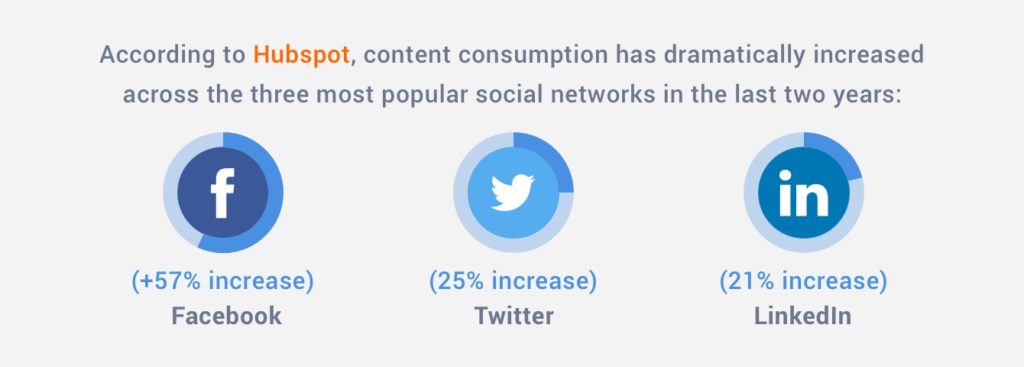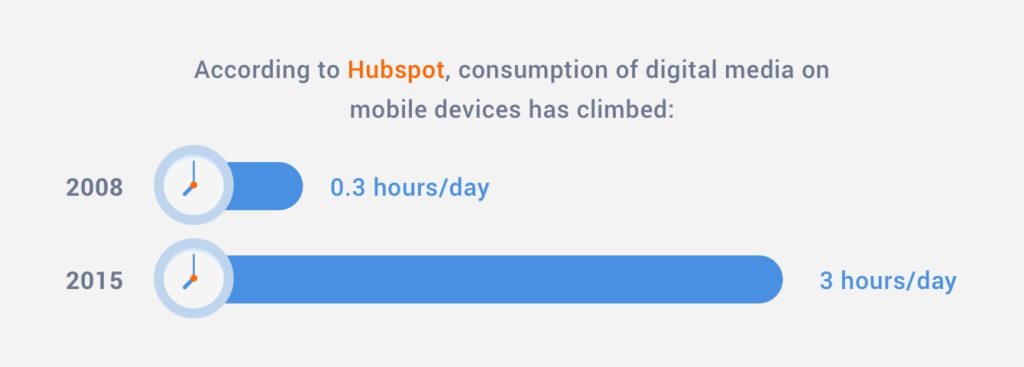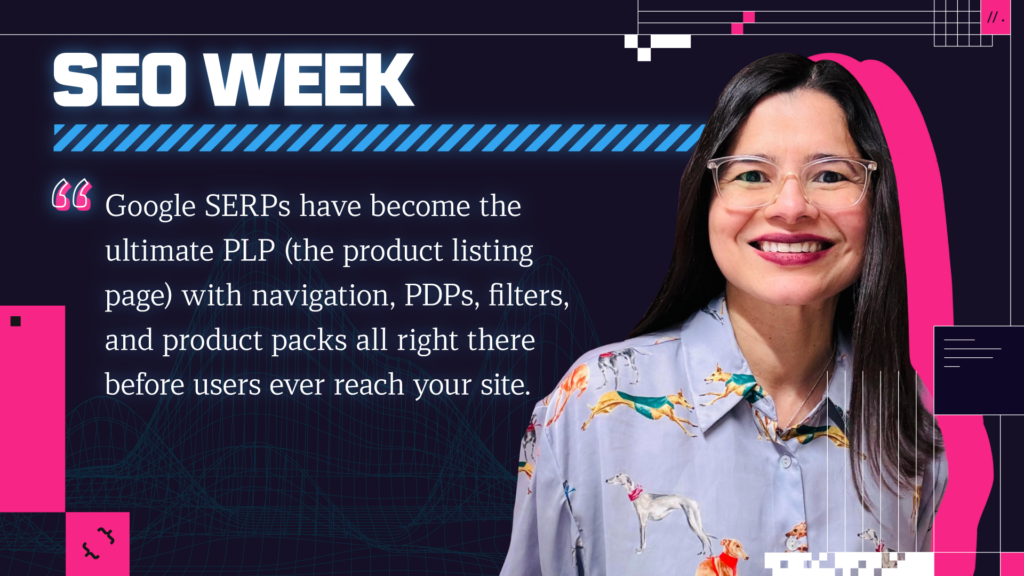These days we are inundated with so much content that sometimes it may seem like your brand or business will never be able to cut through the noise. While digital media interaction is at an all time high (Facebook users share over 2 millions pieces of content a minute) so is digital media consumption.
According to Hubspot, content consumption has dramatically increased across the three most popular social networks in the last two years: Facebook (+57% increase), Twitter (25% increase), and LinkedIn (21% increase).

Consumers are engaging with digital media but there is a ton of noise to cut through to try to reach your audience. Content created now has to be loud, strong and have enough legs to make a big impact long after it is published.
So how do you market a piece of content to ensure that:
1) Your audience sees it
2) Your audience engages with it
You switch from a per diem or single-stream content creation/marketing strategy to a multi-stream one. Sounds simple, right? The common misconception in digital publishing is that once you create a single content piece (blog, EBook, landing page) you promote that single asset, and your work is done. You schedule it in your social calendar. You promote it to your email list, but that is it.
With multi-stream content marketing, the piece itself is designed to be multi-faceted and engineered with marketing in mind. In turn, it does the work for you. Well, sort of.

Multi-Stream Content Creation
At IPR, we think of multi-stream content creation much like a licensing deal. You have a hit album but you also want to license the tracks for use in TV shows, the artist’s likeness for merchandising and so on and so forth. Never is a piece of content simply singular, or a record deal just about music for that matter.
From the outset, when we brainstorm content ideas we are also thinking about how can we extend this beyond its intended location and execution.
-
- What social assets can come from this?
-
- Can specific emails be created to bolster and support this content?
- What about mobile-friendly assets?
Multi-stream content marketing isn’t the same as multi-channel, though they do overlap. Multi-stream looks at all of the related and supporting content materials a brand can create to market and promote the main content piece. These pieces can be and most likely are multi-channel, but they do not have to be.
Here are six ways you can develop a multi-stream content creation strategy.
6 Ways to Do Multi-Stream Content Creation
1. MicroData Visualization

When compiling research and information to build out data visualizations and infographics, there is a large opportunity to create microcontent. By design, data-driven content conveys important information to users and dissecting this content can get stats and details across easier to users. Think of the most comprehensive content you have and then think of how you can syndicate it and create unique, standalone content to extend across social media, email and for use in other content creation projects.
According to the 2020 Content Marketing Industry Report, infographics have had an increase in usage among B2B marketers during the last four years. In 2020, 67% of B2B marketers are creating infographics. When developing a full infographic or a data viz, bake in microcontent including snippets of the full piece or reworked versions to syndicate.
2. Supporting Content

The great thing about content creation is that the world is truly your oyster and there are no real limits (resource and budgetary restrictions notwithstanding) to what you can do. When developing a content marketing activation – an interactive, quiz or guide – there are lots of options for creating supporting content to drive engagement on the main activation.
While shareable results for a quiz are a functional requirement, they can also be standalone content that you syndicate out through social to drive engagement. How about obscuring some of the quiz information to tease the results or create a guide for dealing with your result? If your activation is a B2B Ebook, supporting content can include blog posts, custom imagery and infographics.
3. Custom Imagery

While imagery – whether graphic or photography based – is a standard and must-have in all manners of content, many marketers look past it in terms of it being a standalone asset. Poor imagery, we’ve got your back. While images often need context there is a lot of creatives can do with images to syndicate or extend an initial piece of content.
According to Brain Rules, when people hear information, they’re likely to remember only 10% of that information three days later. However, if a relevant image is paired with that same information, people retained 65% of the information three days later.
All of the images that are included in your content are owned assets that you
can and should syndicate out. For visual mediums like Instagram and Pinterest, custom imagery is great to promote content as well as provide unique content to your audience to share.
4. Multi-Media Content

In 2016, KPCB, a growth accelerator company, projected that by 2017 video would represent nearly 74% of all internet traffic and according to a Hubspot study, 43% of consumers wanted to see more video content. Video and podcasting are hitting hard and engaging users more than articles and blog posts.
While text content will always be needed, more businesses are turning to video content and fitting it into their larger content strategy. While solely creating multimedia content can be expensive or not operationally feasible, leveraging video to extend larger content campaigns or as the tentpole content piece can help engage users on all content fronts.
If your company has a primary video asset, say a commercial or a major product launch, a multi-stream content marketing strategy can include promotion on YouTube, Facebook and owned properties in addition to shorter cuts of the main video to syndicate across these channels and others. If you have a copy based Q&A or interview content, a podcast is a perfect complement that can help you reach audiences that the standard article cannot. And the podcasts can eventually be consolidated into a separate audio section of your website.
5. User-Generated Content

User-generated content. We love you, we love you not. Consumers are engaging with brands and products more than ever and in the world where everyone is a content creator, this presents a tremendous opportunity for brands to tap into another stream of content. Olapic surveyed consumers of all ages to determine how they viewed and interacted with UGC on social media, and they found that 76% of those surveyed thought UGC was more trustworthy than branded content.
So if users trust UGC and your customers are creating it, why not leverage it as a complement to product launches, product pages, and content experiences? The benefit of UGC is that it isn’t resource-intensive and with a few permissions you can leverage beautiful write-ups and images and support the consumers that support your business.
6. Mobile-Friendly Assets

We’re living in a mobile world and that means we as marketers must think beyond our desktop – and I’d venture to say think mobile first. According to Hubspot, consumption of digital media on mobile devices has climbed from 18 minutes per day in 2008 to nearly 3 hours in 2015. What does this mean for multi-stream content? If you have a quiz or interactive experience, what features or functions can you make with mobile in mind?

For your Ebook, is the text and paragraph copy concise enough to consume on mobile? Or better yet, how about implementing a slideshow, scrolling effect for easy consumption and individual sharing. Are the images or graphics comprehensible for mobile or will they be lost on different devices?
It’s a “Multi” World, We’re Just Creating In It
In our multi-screen, multi-channel world, thinking about content from a syndication standpoint can make content marketing a more streamlined and simplistic endeavor. From the ideation phase, you are thinking about all the ways your audience will encounter and meet your content. By breaking up a larger, individual piece into smaller, targeted pieces of content you can ensure that:
- Your content meets your audience where they are
- It engages them in the way they like to be engaged.







